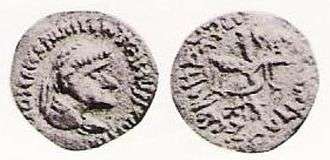Strato II and III
| Strato II | |
|---|---|
| Indo-Greek king | |
|
Coin of Strato II. Obv: Probable bust of Strato II. Greek legend: BASILEOS SOTEROS STRATONOS "Of King Strato the Savior". Rev: Athena holding a thunderbolt. Kharoshthi legend: MAHARAJASA TRATARASA STRATASA "King Strato the Saviour". | |
| Reign | 25 BCE – 10 CE |

Strato II "Soter" (Ancient Greek: Στράτων B΄ ὁ Σωτήρ, Strátōn B΄ ho Sotḗr; epithet means "the Saviour") was an Indo-Greek king. He ruled c. 25 BCE to 10 CE according to Bopearachchi. R. C. Senior suggests that his reign ended perhaps a decade earlier.
Rule
Strato II ruled in the eastern Punjab, probably retaining the capital of Sagala (modern Sialkot, Pakistan), or possibly to the city of Bucephala (Plutarch, p. 48 n. 5).
His territory was invaded by Rajuvula, Indo-Scythian king of Mathura, and he became the last of the Indo-Greek kings, together with his son[1] Strato (III) Soter Philopator ("the father-loving"), who was included as joint regent on some of his coins and also issued coins on his own.
A few silver coins with a different portrait and the inscription Strato Soter Dikaios ("the just") may also belong to Strato III as sole ruler, or to a fourth king named Strato.[2][n 1]
Just like the earlier king Strato I, the last Stratons I are thought to belong to the dynasty of Menander I, who also used the epithet Soter and the symbol of standing Pallas Athena.
Coins of Strato II, III and Strato Dikaios

Obv: Probable bust of Strato II. Possible Greek legend: BASILEOS SOTEROS STRATONOS KAI PHILOPATOROS STRATONOS "Of Kings Strato the Saviour and Strato the Father-loving".[3]
Rev: Athena holding a thunderbolt. Kharoshthi legend: MAHARAJASA TRATARASA STRATASA, POTRASA CASA PRIYAPITA STRATASA "King Strato the Saviour, and his grandson Strato the Father-loving.

The chronology of the late Indo-Greek kingdom has been established by Bopearachchi and other scholars from numismatical evidence alone. The coins deteriorated continuously, the Strato coins being the most debased and crude in style, a striking contrast to earlier kings who struck some of the most beautiful coins of antiquity.
The decay was due to the increasing pressure of the Indo-Scythian nomads on the remaining Greek pockets, as well as their long isolation from the rest of the Hellenistic world.Subsequent Indo-Scythian rulers, such as Bhadayasa designed their coins in direct imitation of those of Strato II.
Strato II, III and Strato Dikaios struck debased silver drachms, which as mentioned portray Pallas on the reverse. Strato II appears as an old man with a sunken jaw on some of his coins, which is not surprising given that his grandson was co-regent.
Strato II also issued bronzes and even lead coins of the common type Apollo/tripod. On some of Strato II's silver drachms the letter sigma is written as C, a not uncommon trait on late Hellenistic coins in the east.
See also
Notes and references
Notes
- ↑ Given that the coins of Strato I have lately been attributed to two different kings, there may actually have been as many as five kings named Strato.
References
- ↑ R.C. Senior, Indo-Scythian coins and history. Volume IV. The Greek legend clearly implies that the two kings were father and son, and Senior dismisses the older reading "grandson" on the Kharosthi legend.
- ↑ Senior, ibid.
- ↑ Rapson, E.J. (1906). "Coins of the Graeco-Indian sovereigns agathokleia, Strato I Soter, and Strato II Philopator". Corolla Numismatica. Numismatic essays in honour of Barclay V. Head. With a portrait and eighteen plates. Oxford. At the Internet Archive.
- ↑ O. Bopearachchi, "Monnaies gréco-bactriennes et indo-grecques, Catalogue raisonné", Bibliothèque Nationale, Paris, 1991, p.453
Bibliography
- Whitehead, R.B. (1914). Catalogue of coins in the Punjab museum, Lahore. I Indo-Greek Coins. Oxford. At the Internet Archive.
External links
- (French) Straton II, roi indo-grec
| Preceded by Apollophanes |
Indo-Greek ruler (Eastern Punjab) 25 BCE – 10 CE |
Office abolished |
